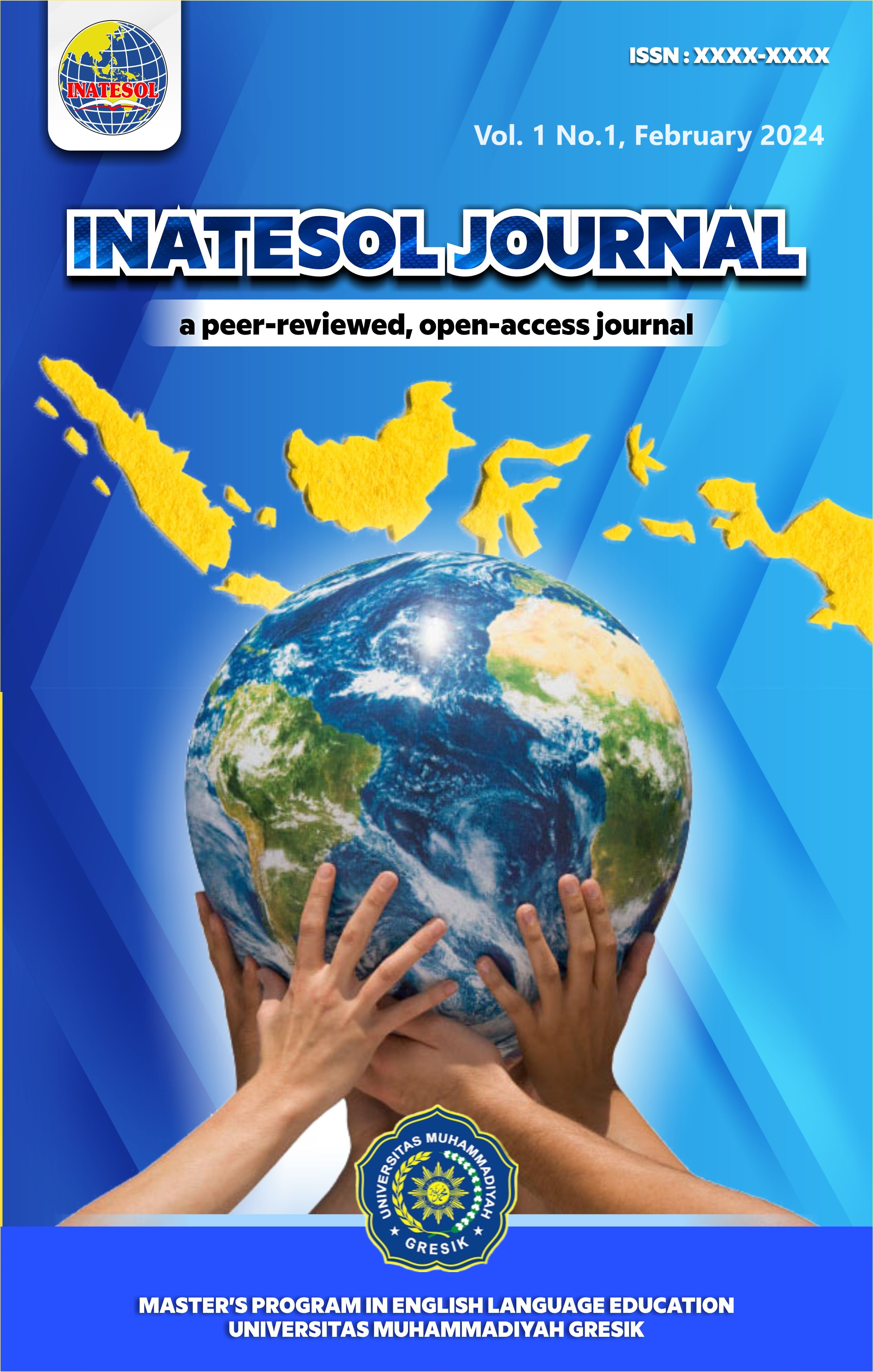THE IMPACT TEACHING ENGLISH USING VIDEO ON STUDENTS VOCABULARY MASTERY IN THAILAND
DOI:
https://doi.org/10.30587/inatesol.v1i1.7536Keywords:
Video,vocabulary,EYL StudentAbstract
This study aims to determine whether there is an impact of teaching English using videos on students' vocabulary skills at Anuban Chumchon Phukradueng School. The researcher used a quasi-experimental design to determine the comparison between two groups that received different treatments. The total population of grade 5 was 94 students, but the researcher decided to select two classes 5.2 and 5.3 after getting recommendations from the school and finding that the two classes were equal. Researchers used tests as instruments to collect data and the final result of this study is that teaching English using videos has a very significant impact on students' vocabulary skills.
References
Ai-Lim Lee, E., Wong, K. W., & Fung, C. C. (2010). How does desktop virtual reality enhance learning outcomes? A structural equation modeling approach. Computers and Education, 55(4). https://doi.org/10.1016/j.compedu.2010.06.006
Almurashi, W. A. (2016). THE EFFECTIVE USE OF YOUTUBE VIDEOS FOR TEACHING ENGLISH LANGUAGE IN CLASSROOMS AS SUPPLEMENTARY MATERIAL AT TAIBAH UNIVERSITY IN ALULA. In International Journal of English Language and Linguistics Research (Vol. 4, Issue 3). https://www.youtube.com/watch?v=ssuiqtreiBg.
ALQAHTANI, M. (2015). The importance of vocabulary in language learning and how to be taught. International Journal of Teaching and Education, III(3), 21–34. https://doi.org/10.20472/te.2015.3.3.002
Berne, J. I., & Blachowicz, C. L. Z. (2008). What Reading Teachers Say About Vocabulary Instruction: Voices From the Classroom. The Reading Teacher, 62(4). https://doi.org/10.1598/rt.62.4.4
Cresswell, J. W. (2012). Research design: pendekatan kualitatif, kuantitatif, dan mixed (3rd ed.). Yogyakarta: Pustaka Pelajarar.
Furqon. (2011). STATISTIKA TERAPAN UNTUK PENELITIAN (7th ed., Vol. 284). ALFABETA: BANDUNG.
Gay, L. R. (1987). Educational Research: Competencies for Analysis and Applications (3rd ed., Vol. 614). London: Merrill Publishing Company.
Harmer, J. (1998). How to teach English: an Introduction to the Practice of English Language Teaching. In England.
Harmer, J. (2007). The_Practice_of_English_Language_Teaching.
Heaton J. B. (1990). Classroom testing. Longman.
Hubbard, P. (2009). Computer Assisted Language Learning: Critical concept in linguistics. Foundations of CALL, 1.
Huckin, T., Haynes, M., & Coady, J. (1993). Second language reading and vocabulary learning. Applied Psycholinguistics, 17(3).
Jacobson, E., Degener, S., & Purcell-Gates, V. (2003). Creating authentic materials and activities for the adult literacy classroom: A handbook for practitioners. In Ncsall.
Juhana. (2014). Teaching English to young learners : Some Points to be Considered. Asian Journal of Education and E-Learning, 02(01).
Khalidiyah, H. (2005). THE USE OF ANIMATED VIDEO IN IMPROVING STUDENTS’ READING SKILL (A Quasi-Experimental Study of Seventh Grade Student at A Junior High School in Jalancagak, Subang). In Journal of English and Education (Vol. 2015, Issue 1).
Lutviana, R., & Mafulah, S. (2017). The Use of Video and TPR to Improve Students’ Vocabulary Mastery. EnJourMe (English Journal of Merdeka) : Culture, Language, and Teaching of English, 2(2). https://doi.org/10.26905/enjourme.v2i2.1970
Mamuko, Ephifania. 2017.The Use Of Video Blog To Learn English Vocabulary.
Sarjana thesis, Universitas Brawijaya.
Meara, P. (1980). Vocabulary acquisition: a neglected aspect of language learning.
Mishabuddin, & Hasan, I. (2013). Analisis data penelitian dengan statistik (ed. 2). Jakarta : Bumi Aksara.
Nasution. 2005. Teknologi Pendidikan. Jakarta: Bumi Aksara.
Nation, I. S. P. (2001). Learning Vocabulary in Another Language. Cambridge University Press. https://doi.org/10.1017/CBO9781139524759
Pratiwi Rahmadhani, A. (2015). Techniques in Teaching Vocabulary to Young Learners at LIA English Course. TELL-US Journal, I(2).
Rahmah, Ferria Afia. 2015. The Effectiveness of Using English Songs from
YouTube Towards Students’ Vocabulary Mastery. Jakarta: (Skripsi).
http://repository.uinjkt.ac.id
Riswandi, D. (2016). Use of YouTube-Based Videos to Improve Students’ Speaking Skill. In Proceeding of the international conference on teacher training and education (Vol. 2, Issue 1).
Shejbalova, D. (2006). METHODS AND APPROACHES IN VOCABULARY TEACHING AND THEIR INFLUENCE ON STUDENTS’ ACQUISITION.
Taniredja, T., & Mustadifah, H. (2011). Penelitian kuantitatif : sebuah pengantar (3rd ed., Vol. 262). Bandung : Alfabeta.
Wallace, B. (1989). Book Review: Teaching Thinking Skills. Gifted Education International, 6(2), 127-127. https://doi.org/10.1177/026142948900600221
Downloads
Published
How to Cite
Issue
Section
License
Authors who publish with this journal agree to the following terms:
- Authors retain copyright and grant the journal right of first publication with the work simultaneously licensed under a Creative Commons Attribution License that allows others to share the work with an acknowledgement of the work's authorship and initial publication in this journal.
- Authors are able to enter into separate, additional contractual arrangements for the non-exclusive distribution of the journal's published version of the work (e.g., post it to an institutional repository or publish it in a book), with an acknowledgement of its initial publication in this journal.
Authors are permitted and encouraged to post their work online (e.g., in institutional repositories or on their website) prior to and during the submission process, as it can lead to productive exchanges, as well as earlier and greater citation of published work (See The Effect of Open Access).



_3.png)
_2.png)



